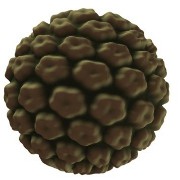 Photo: Getty Images
Photo: Getty Images
More and more each month it seems we are reading and learning of the extensive spread of the human papillomavirus (HPV). Unfortunately, it doesn’t seem to be losing steam.
HPV – leading cause of cervical cancer in women – is the second most common cause of cancer death for women and is a common cause of cervical and anogenital cancers, and some portion of head and neck cancers, particularly oral cavity and oropharynx cancers.
"Currently, there is no cure for HPV, and the available treatment options involve destroying the affected tissue. We have developed a protein inhibitor that blocks HPV protein expression in cell culture, a first step toward a topically-applied treatment for this cancer-causing virus," said senior author James Baleja, PhD, associate professor of biochemistry at Tufts University School of Medicine (TUSM) and member of the biochemistry program faculty at the Sackler School of Graduate Biomedical Sciences at Tufts.
James Baleja, PhD, is part of a team of researchers from Tufts University School of Medicine who have developed a protein-based inhibitor that could provide a topical treatment for HPV.
The study was funded by the National Institutes of Health and published online in The Journal of the Federation of American Societies for Experimental Biology (FASEB Journal). Researchers report that patients infected with cancer-causing HPV may someday have an alternative to surgical and harsh chemical treatments.
According to the study, “HPV affects approximately 20 million people in the United States, making it the most common sexually transmitted infection. There are more than 100 types of HPV of which more than 40 are sexually transmitted. These include two high-risk types, HPV-16 and HPV-18, which cause the majority of cervical and anogenital cancers, and some portion of head and neck cancers, particularly oral cavity and oropharynx cancers. Cervical cancer is diagnosed in nearly 500,000 women each year, killing 250,000 annually.”
The study further provides that “In the United States, it was estimated that 12,000 women in 2010 would be diagnosed with cervical cancer, while 10,100 women and men in the United States get vulvar, vaginal, penile or anal cancers each year. In addition, some portion of the head and neck cancers in the United States (11,300 men and women each year) is attributable to HPV. Other types of HPV, or low-risk HPV, can cause genital warts or are infections that clear on their own.”
Baleja and his team sought out to inhibit HPV and in doing so, zeroed in on the viral protein E2, which controls viral activities including DNA replication and the activation of cancer-causing genes.
The Tufts research team used structure-guided design to develop a protein called E2R that prevents E2 from functioning normally. When the researchers applied E2R to a cell model of HPV biology, viral gene transcription was halted. Because HPV infects epithelial cells, the outermost layer of the skin and the mucous membranes, protein inhibitors such as E2R could be applied in a topical form.
"Vaccines are helping to lower the incidence of HPV, but vaccines will not help the millions of women and men who currently have an infection, especially those who have high-risk and persistent infections. Social and economic challenges make widespread administration of a vaccine difficult, particularly in developing countries. A topical treatment for HPV could provide an economical option," Baleja said.
The most stable inhibitor was found to inhibit the E2 protein of HPV-16, the high-risk strain that is most commonly associated with cancers. The data in this study suggest that the inhibitor may also be effective against another high-risk virus, HPV-18, as well as a low-risk virus, HPV-6a, which causes warts.
This research could mean treatment of serious HPV cases will be more economical and widespread, to help combat the ever-growing killer of women in the U.S. and around the world. So while the incidence of HPV isn't losing its steam, researchers and doctors may have found a less invasive way to treat the virus.
Protein inhibitor may bring a topical treatment for HPV
http://www.eurekalert.org/pub_releases/2011-04/tuhs-pim042611.php
Design and characterization of an enhanced repressor of human papillomavirus E2 protein.
http://www.ncbi.nlm.nih.gov/pubmed/21482558
Center for Disease Control and Prevention
http://www.cdc.gov/hpv/cancer.html






Add a CommentComments
There are no comments yet. Be the first one and get the conversation started!